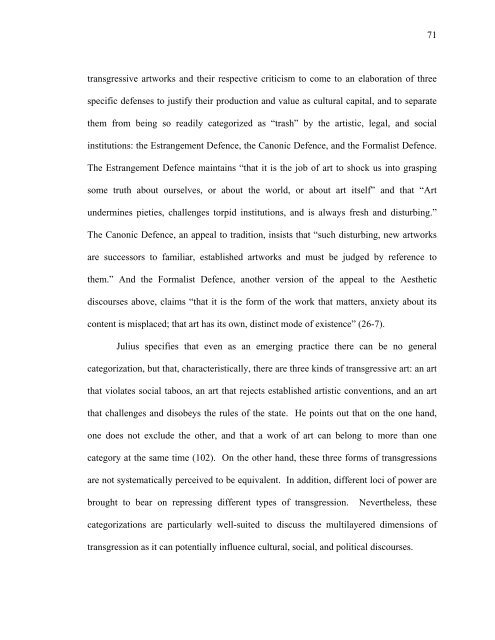Untitled - Sexey's School Moodle
Untitled - Sexey's School Moodle
Untitled - Sexey's School Moodle
Create successful ePaper yourself
Turn your PDF publications into a flip-book with our unique Google optimized e-Paper software.
transgressive artworks and their respective criticism to come to an elaboration of three<br />
specific defenses to justify their production and value as cultural capital, and to separate<br />
them from being so readily categorized as “trash” by the artistic, legal, and social<br />
institutions: the Estrangement Defence, the Canonic Defence, and the Formalist Defence.<br />
The Estrangement Defence maintains “that it is the job of art to shock us into grasping<br />
some truth about ourselves, or about the world, or about art itself” and that “Art<br />
undermines pieties, challenges torpid institutions, and is always fresh and disturbing.”<br />
The Canonic Defence, an appeal to tradition, insists that “such disturbing, new artworks<br />
are successors to familiar, established artworks and must be judged by reference to<br />
them.” And the Formalist Defence, another version of the appeal to the Aesthetic<br />
discourses above, claims “that it is the form of the work that matters, anxiety about its<br />
content is misplaced; that art has its own, distinct mode of existence” (26-7).<br />
Julius specifies that even as an emerging practice there can be no general<br />
categorization, but that, characteristically, there are three kinds of transgressive art: an art<br />
that violates social taboos, an art that rejects established artistic conventions, and an art<br />
that challenges and disobeys the rules of the state. He points out that on the one hand,<br />
one does not exclude the other, and that a work of art can belong to more than one<br />
category at the same time (102). On the other hand, these three forms of transgressions<br />
are not systematically perceived to be equivalent. In addition, different loci of power are<br />
brought to bear on repressing different types of transgression. Nevertheless, these<br />
categorizations are particularly well-suited to discuss the multilayered dimensions of<br />
transgression as it can potentially influence cultural, social, and political discourses.<br />
71



